African American Skin Treatment & Dermatology
Different skin tones require different skincare. Patients with darker skin tones are much more prone to experiencing skin concerns such as hyperpigmentation and keloid scarring than those with lighter skin tones, and this is an essential consideration to make when selecting ideal skincare products and in-office cosmetic treatments. Melanoma, the most severe form of skin cancer, is also often overlooked in patients with darker skin tones, being diagnosed in much later stages than in patients with light skin. Dr. Michele Green in New York City is a board-certified cosmetic dermatologist with over two and a half decades of providing patients from around the world, with all different skin tones, with the best in everything related to overall skin health and appearance.
It’s important for dermatologists to have a thorough understanding of how skin conditions manifest in patients of different skin tones, as well as have the expertise to recommend treatments that are appropriate, safe, and effective. Patients of different skin tones should not be disadvantaged when it comes to receiving proper care for their skin due to a healthcare provider’s inexperience with their skin tone. Not only do some skin conditions, like eczema and psoriasis, present differently in patients with darker skin tones, but the treatments that are appropriate for managing different dermatological conditions can also be influenced by the skin tone of a patient.
Michele Green, MD, FAAD in New York City, is a cosmetic board-certified dermatologist with a wealth of experience treating patients of different ethnicities, male and female, at her private office in the Upper East Side Neighborhood of New York City. New York City prides itself on being one of the most ethnically diverse cities in the world, and Dr. Green uses the latest technology in dermatology treatments, including chemical peels, Cosmelan, and laser skin treatments, to find the best solution for patients with any skin tone. From skin cancer to hair loss, ethnic skin needs special care and thoughtful consideration, and Dr. Green always prioritizes customizing patient treatment plans to cater to their unique needs. The following guide provides an overview of some of the more common issues surrounding darker skin tones and the treatments that Dr. Green utilizes at her NYC dermatology office.
African American Skin
African American skin varies in tones and shades and differs in skin properties from lighter skin tones. Studies have found that the dermis, the middle layer of the skin, tends to be thicker due to a higher amount of collagen in the skin. This means that the skin has better protection against the visible signs of aging, such as fine lines, wrinkles, sun damage, and skin laxity. Fibroblasts, the skin cells responsible for collagen production, are also at a higher concentration in darker skin. A higher concentration of fibroblasts can lead to an increased risk of thick scars and keloids. Melanocytes are the skin cells that are responsible for generating pigment or melanin. In individuals with darker skin, the melanocytes produce more melanin than in individuals with lighter skin. Melanin is the pigment that determines skin color. This increased amount of melanin is beneficial in protecting the skin from sun damage and sunburns; however, it also contributes to making darker skin-toned individuals more prone to discoloration because the melanocytes are more sensitive. Hyperpigmentation and an uneven skin tone are common issues in African American skin. Furthermore, there is evidence that suggests that black skin has higher transepidermal water loss, which means that darker skin loses moisture more easily. Patients with darker skin tones do not need to have their evaluation and treatment from an African American dermatologist to receive proper care, so long as their derm provider has the experience and cultural competency required to recommend the skincare products and treatment options that are best suited to their unique skin concerns.
Skincare for skin of color
Proper skin care for patients with darker skin tones is extremely important since ethnic skin is very sensitive. There are unique considerations in treating dark skin, which one must be cognizant of to treat skin of color effectively and safely. Darker skin tones are much more susceptible to discoloration and hyperpigmentation. Since darker skin tones are more prone to hyperpigmentation and sunspots, proper sunscreen is essential to use on a daily basis. Dr. Green recommends an SPF of 50 daily, which has both UVA and UVB (broad-spectrum) protection. Vitamin C serum is also a very effective antioxidant to help repair the daily damage from the sun and restore an uneven complexion. Gentle cleansers are also vital for sensitive skin, as are daily moisturizers that hydrate the skin and restore and maintain its natural protective barrier. In acne-prone skin, it is very important to use non-comedogenic products. This is especially true in patients with darker skin, as they are more susceptible to hyperpigmentation and dark scars from acne breakouts. The HydraFacial medical-grade facial treatment is also a very effective way to maintain healthy and radiant skin, as well as prevent and treat discoloration and uneven skin tone.
Dark Spots in Skin of Color
For patients with darker skin tones, there can potentially be some issues with certain chemical peels and laser treatments. Traditionally, many of the techniques for eliminating the appearance of dark spots that may be suitable for patients with lighter skin tones are not necessarily effective on darker skin and can even be potentially damaging. Due to the increased amount of melanin in darker skin, many laser devices can run the risk of potentially burning healthy skin. Another potential serious side effect that can be caused by these treatments is an “over lightening” of the skin color, resulting in hypopigmentation. Patients with darker skin tones that want to diminish the appearance of dark spots and hyperpigmentation should opt for light chemical peel treatments and avoid laser treatments and strong chemical peels, since these can potentially cause hypopigmentation, exacerbation of hyperpigmentation, and even scarring. When you consult with Dr. Green in NYC for your dark spot treatment, she will work with you to create a customized treatment plan that is best suited to your skin concerns and skin type.
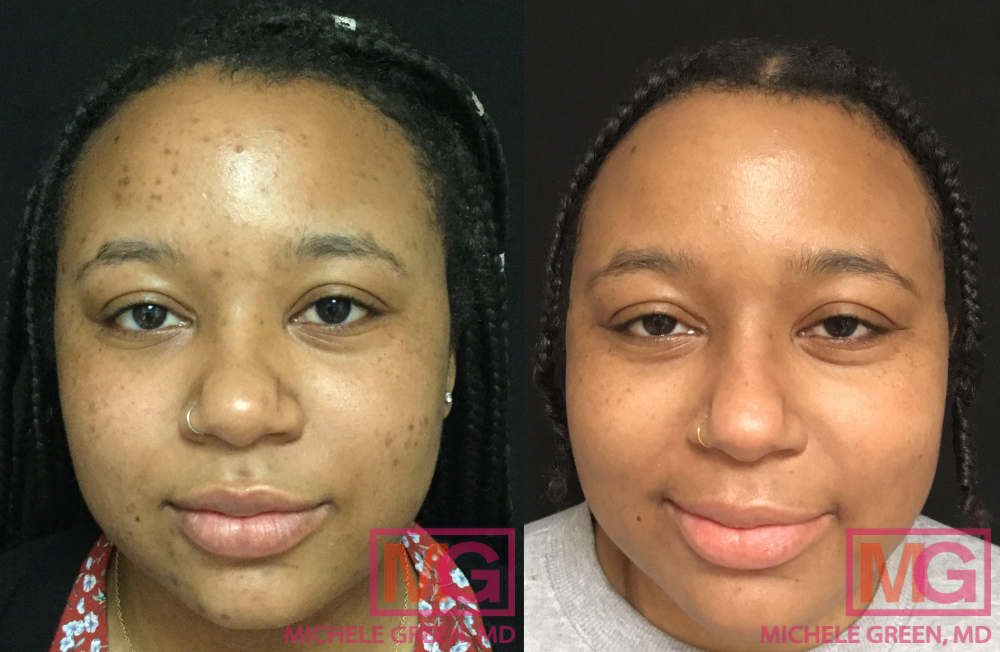
What causes skin discoloration in African Americans?
Skin discoloration can occur for a variety of reasons. Skin discoloration may be characterized by hyperpigmentation, where skin color is darker than the surrounding healthy skin, and hypopigmentation, where skin color is lighter than the surrounding skin. Because ethnic skin naturally has a higher amount of melanin or pigment in the skin, it is more susceptible to hyperpigmentation. Some causes of hyperpigmentation may include acne, eczema, and sun exposure, where an excess amount of melanin forms in the skin, leading to the skin appearing discolored. Skin conditions like acne and eczema are associated with inflammation, which stimulates melanocytes or pigment-producing skin cells to increase melanin production. Similarly, post-inflammatory hyperpigmentation (PIH) is common in dark skin, and dark patches of skin can develop after an injury, inflammatory response, or laser treatments. Additionally, the skin produces melanin to naturally protect itself from the damaging effects of the sun; however, when the skin is exposed to ultraviolet (UV) rays, it can cause an uneven increase in melanin synthesis that produces an irregular pigmentation of the skin. Another form of hyperpigmentation is melasma, a skin condition characterized by blotchy brown, dark brown, or gray-brown patches of the skin. Sun exposure and hormone fluctuations are two of the largest contributing factors to the onset of melasma.
Hypopigmentation occurs when the skin loses pigment and becomes lighter than the surrounding skin. It can happen from injury to the skin as a wound heals, such as burns, infections, and blisters. The remaining scars from the injury may be lighter than the surrounding skin. Hypopigmentation of the skin can also be due to vitiligo, a skin condition in which the body’s immune system attacks the melanocytes, leaving patches of skin lighter than others. Hypopigmentation can also be caused by tinea versicolor, a fungal infection, psoriasis, and eczema, as well as laser skin resurfacing, laser hair removal, chemical peels, and dermabrasion. Therefore, it is important to seek a board-certified dermatologist who will consider your skin type to determine the safest, most effective treatment option. If you experience any skin discoloration, be sure to reach out to Dr. Green’s office in New York City before undergoing any at-home or in-office cosmetic treatments.
Cosmelan for Melasma in skin of color
Melasma (also known as the mask of pregnancy) manifests in facial hyperpigmentation, which can be caused by hormones, sun exposure, and various other factors. Patients with darker skin tones are prone to produce an excess of melanin, which can cause the skin to be darker in certain areas. Since dark skin is prone to this discoloration and hyperpigmentation, treating this skin concern is one of the most popular procedures in Dr. Green’s NYC office. Cosmelan is a type of chemical peel commonly used in Melasma treatment and can help treat this type of hyperpigmentation.
Cosmelan masks include a professional-grade cream that is applied in Dr. Green’s office. The mask is left in place for several hours and then can be easily removed by the patient at home using a gentle cleanser. Maintenance products will be provided at your Cosmelan appointment for you to use at home. One must also avoid sunlight during this period to achieve and maintain the best cosmetic results. Dr. Green has all Cosmelan patients return about 4 weeks after the treatment to reassess and determine the next course of action to achieve the desired results.
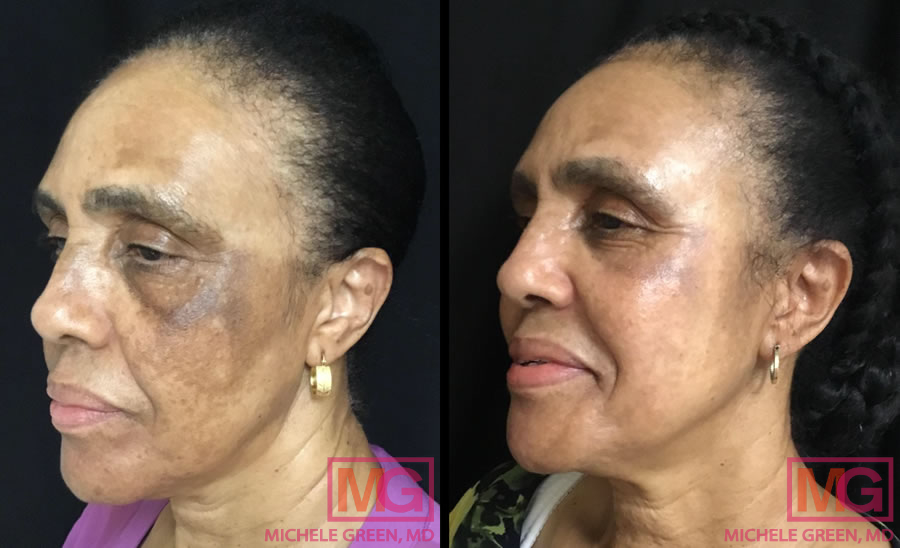
Cosmelan treatment – 8 months
Skin Lightening in Skin of Color
Another treatment that Dr. Green is often asked about is skin lightening techniques to achieve a brighter and more even skin tone. Here, the goal is to brighten the skin and improve the overall look and feel without overly lightening the skin. There are several methods available to lighten the skin, such as Cosmelan, chemical peels, Mesopeels, hydroquinone products, and laser treatments. Different skin tones require different targeted skincare products, and not all treatment options are safe for dark skin. Any cosmetic treatment that is designed to lighten dark spots and hyperpigmentation should be performed carefully by an experienced and certified expert to prevent any potential adverse reactions and unwanted exacerbation of hyperpigmentation. The best approach initially is to book a consultation with Dr. Green to discuss the results that you are looking to achieve, and she will design a tailored course of treatments that is safe for your skin type.
Acne Scarring and Hyperpigmentation in African American skin
There are several different ways to treat the scarring that has resulted from a previous episode of acne; however, not all the treatments on the market are necessarily suitable for darker skin tones. For example, African American patients respond differently to laser treatments than those with lighter skin types. The goal is to prevent acne breakouts and provide the best acne treatment to avoid unwanted acne scarring and dark spots. Since skin of color is prone to hyperpigmentation due to the increased melanin, careful laser selection and use of these lasers are critical in having safe and effective cosmetic results.
One skin issue that commonly affects darker skin is post-inflammatory hyperpigmentation (PIH), which results in the darkening of the skin from acne and acne scars. This discoloration or pigmentation can occur in Asian, Hispanic, & Native American skin tones, in addition to African American skin. The best treatment for this type of hyperpigmentation and dark scars is chemical peels combined with topical skin-lightening agents. Dr. Green utilizes her unique MGSKINLABS line of skin care products with powerful hydroquinone and retinoids to treat these problem areas. After a series of chemical peels, the discoloration will be reduced, and your skin tone will be even and restored. Proper sunscreen and sun avoidance are essential in maintaining the best results.
In addition to chemical peels, acne scars can be treated with laser treatments and dermal fillers. The eMatrix laser is a “color blind” laser, and through radiofrequency heat, acne scars are improved, and new collagen is stimulated. With a series of eMatrix laser treatments, the appearance of acne scars can be minimized and your complexion restored. Dr. Green combines laser treatments with dermal fillers, such as Restylane, Sculptra, Bellafill, and Juvederm, to immediately restore lost collagen and volume in all types of acne scars. This immediate improvement in scars also has long-term improvement in stimulating new collagen production. Dr. Green is an expert in treating acne scars and combines multiple modalities, especially in patients with ethnic skin.
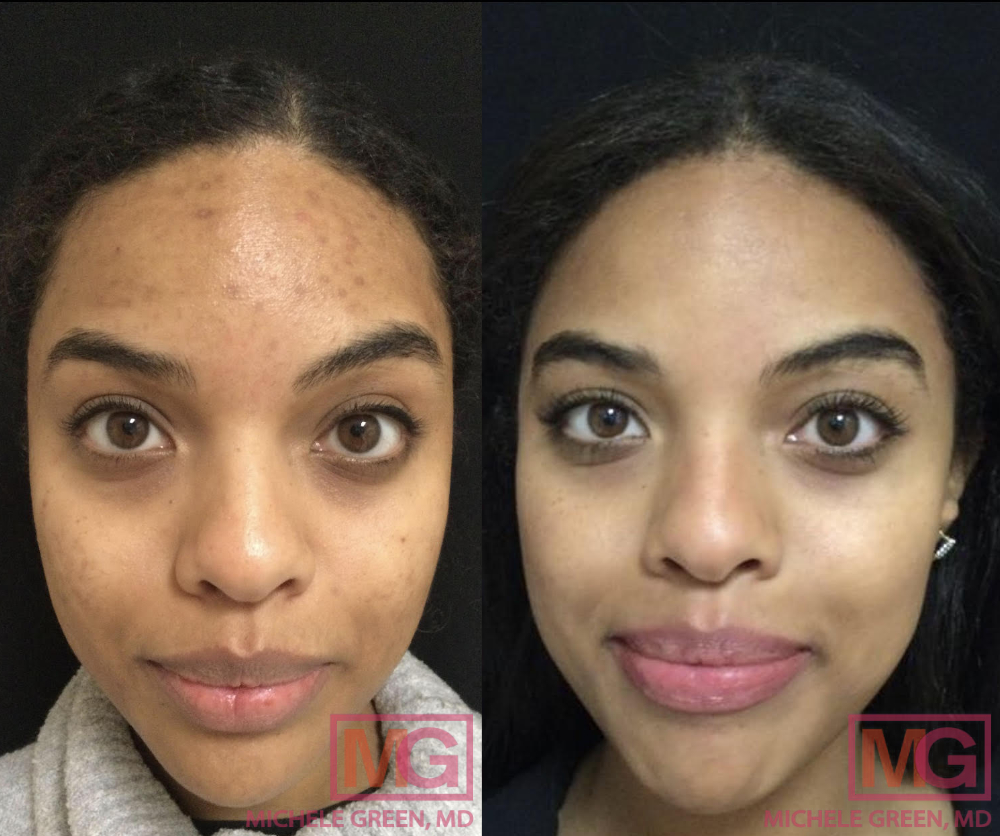
Acne treatment, 10 months before and after
Is retinol good for black skin?
Yes! Retinol is a form of vitamin A that has become a popular skincare ingredient, especially in anti-aging products. Retinol can deliver the same benefits for patients with darker skin. Retinol works by increasing skin cell turnover, exfoliating dead skin cells, and stimulating collagen production. This reduces the appearance of fine lines and wrinkles and creates a plumper, brighter complexion. Retinol can also be used as a topical treatment to help combat the visible signs of aging and rejuvenate the skin. Retinol can also benefit acne-prone skin because it prevents clogged pores that cause acne lesions. When choosing OTC retinol products, pay close attention to the percentage listed in the ingredients list. Any OTC products claiming to have prescription-strength retinol may be too harsh for black skin and may potentially cause irritation and skin discoloration. Most importantly, retinol should be used at nighttime, followed by sunscreen the next morning. Retinol makes the skin photosensitive, which means the skin is more sensitive to the effects of the sun. With any new skincare products, it is always best to consult with a board-certified dermatologist like Dr. Green, who is experienced in treating skin of color before using the product.
What is the best facial cleanser for African American skin?
The best facial cleanser for African American skin will be a non-irritating and gentle formula. CeraVe Foaming Face Wash is a perfect gentle cleanser option for sensitive and acne-prone skin. The formula effectively achieves a deep cleanse without any harsh exfoliating agents that may lead to skin irritation. This cleanser is also packed with hyaluronic acid, niacinamide, and essential ceramides that provide essential skin hydration. These ingredients boost the health of the natural protective barrier of the skin, enhancing skin protection, and helping the skin look and feel its best. When you consult with board-certified cosmetic dermatologist Dr. Michele Green in her boutique dermatology office located in the Upper East Side neighborhood of Manhattan, you’ll have the opportunity to discuss with her in-depth your specific skin concerns, and discover which skincare products are best for you and your skin.
What is the best facial product for African American skin?
SPF is one of the most important facial products for patients of every skin tone. Although African Americans are less likely to develop skin cancer due to some natural sun protection provided by melanin in the skin, black patients who are diagnosed with skin cancer are, unfortunately, diagnosed in later stages than patients with light skin tones. Having regular skin cancer screenings and wearing sunscreen daily can help keep patients healthy. Sunscreen should be broad-spectrum, indicating that it protects against both UVA and UVB rays. It should also have a minimum SPF of 50 and be reapplied every 1.5-2 hours for the best coverage. Active ingredients like zinc oxide and titanium dioxide should be included in the sunscreen’s formula. Regular use of sunscreen can also help protect against the development of melasma. Melasma is a skin condition characterized by brown or gray-brown patches on the skin that are darker in color than the rest of the surrounding skin. Because African American skin is more susceptible to the development of melasma and hyperpigmentation, skin-brightening ingredients like vitamin C are one of the best to incorporate into a daily skincare regimen. Vitamin C is a powerhouse of a skincare ingredient, boosting collagen production in the skin that leads to firmer, brighter, smoother, and healthier skin overall.
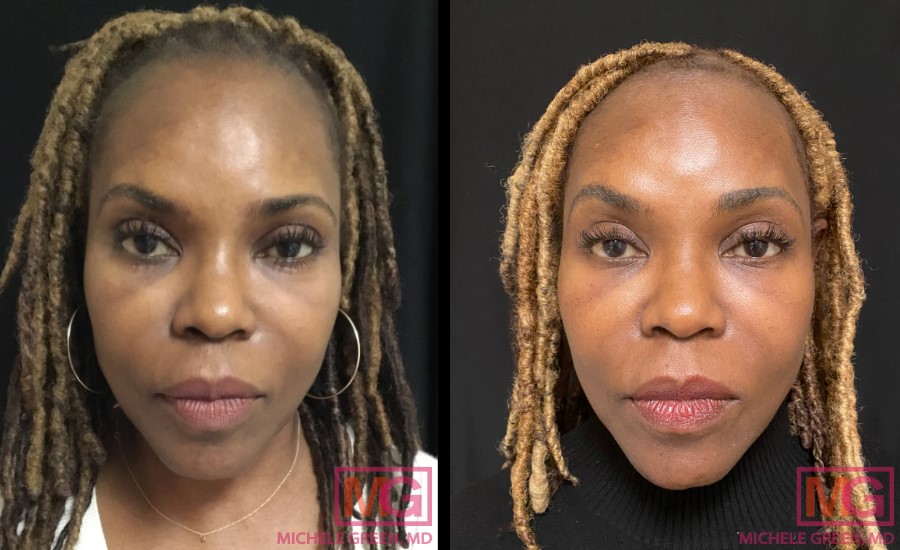
Botox, Voluma 1 syringe and Juvederm 1 syringe
What is the best acne treatment for African American skin?
Early intervention for acne breakouts is very important for skin of color because it can prevent unwanted complications from acne, such as scarring and dark spots. Therefore, the first step in finding the best acne treatment for black skin is to consult a board-certified dermatologist like Dr. Green in NYC. It is very important to avoid picking, popping, or squeezing pimples, as this damages the skin and increases the risk of infection and permanent acne scarring.
Various topical and oral medications can be prescribed by Dr. Green to treat acne. Oral antibiotics, such as doxycycline and minocycline, are commonly prescribed for acne treatment. Topical antibiotics, such as clindamycin and erythromycin, are commonly prescribed in cream or gel form as well. Other oral medications may include birth control pills or spironolactone, which can help prevent acne flare-ups that occur around menstruation. Isotretinoin, also known as Accutane, is an effective oral medication that improves acne long-term by reducing the size of sebaceous glands that produce oil, thereby preventing clogged pores. Other brand names for isotretinoin include Absorica, Amnesteem, Claravis, Myorisan, and Zenatane.
There are many acne-fighting skincare products available over the counter that are safe to use on darker skin tones. One ingredient to look for is salicylic acid, a type of chemical exfoliant that deeply cleanses the pores. Consistent use of salicylic acid cleansers can prevent acne lesions from developing. Benzoyl peroxide is another common acne treatment, especially for inflammatory acne. Benzoyl peroxide not only exfoliates the skin but also kills acne-causing bacteria. HydraFacials are a unique way to unclog the skin, remove blackheads, and treat acne without any downtime or discomfort.
Keloid Scars and treatment options in darker skin
A keloid is an overgrowth of scar tissue that develops around a wound, typically after the wound has healed. Approximately ten percent of individuals experience keloid scars. Keloids most commonly develop in patients with darker skin tones, especially in African American patients. Typically, keloids affect younger patients between 15 and 30 years of age. Keloid scars can occur years after the initial scar is created and tend to occur most often on the face, earlobes, neck, and chest areas. Studies have shown that there is a genetic predisposition to keloid scars, which may be related to the AHNAK gene. There are many skin injuries that predispose to keloid formation. The most common injuries which result in keloid scars are:
- Acne scars
- Surgical scars
- Ear piercing
- Vaccination sites
- Chicken pox scars
- Burns
Keloids can be a cosmetic issue since the keloid scar is often much larger than the original wound. Dr. Green has great success in treating these keloid scars with a combination of VBeam laser treatments and intralesional cortisone injections. In recalcitrant cases, Dr. Green may recommend surgical removal of a very large keloid scar. Topical silicone gel pads also help reduce pressure on keloids and minimize their formation.
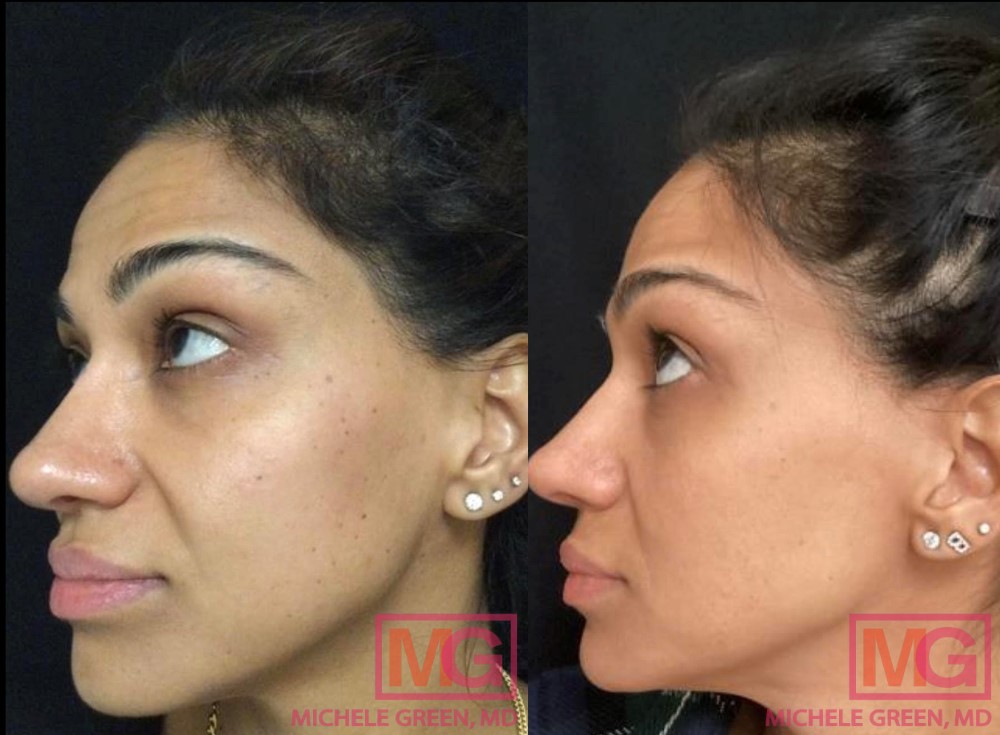
6 months after DPN treatment
Dermatosis Papulosa Nigra
Dermatosis Papulosa Nigra (DPN) is a skin condition in which small, firm, dark bumps or papules can develop on the face and neck. These epidermal growths are benign, and their presence does not pose any risk to your overall health. It often presents first during adolescence and gradually becomes more pronounced with age. DPNs are very common in African American skin, presenting in 35% of black Americans, and can also occur among Asians and Polynesians with darker skin. Women are twice as likely to develop these benign growths than men.
DPNs are likely hereditary, and studies show that 40-50% of patients with DPN have a family history of these growths. Studies have suggested that there is a potential association between DPNs and ultraviolet exposure, as the growths commonly present on the face, neck, and upper trunk where the UV exposure is at its greatest. Treatment is not necessary for DPNs, but the presence of these dark spots may affect a patient’s self-esteem and social life. Cosmetic removal of DPNs is a common procedure performed in dermatology. Because darker skin tones are prone to discoloration, cosmetic treatment of DPNs should be performed by an experienced dermatologist, such as Dr. Michele Green.
Vitiligo
Vitiligo is a chronic skin condition characterized by patches of hypopigmented or lighter skin that usually increase in size with age. Vitiligo can also affect other parts of the body, such as hair and eyes. When vitiligo affects the scalp, it often presents as patches of white hair growth. Vitiligo occurs when the body attacks its own melanocytes, which are the skin cells responsible for producing melanin, or skin pigment. Therefore, vitiligo may be an autoimmune disease where the immune system attacks its own body’s cells. The exact cause of vitiligo is unknown, though it has been found to be not contagious and not life-threatening. There may be a genetic component involved in vitiligo, as it often presents in patients with a family history. However, vitiligo often negatively affects one’s self-esteem and social life and can even lead to serious depression. There is not yet a cure available for Vitiligo, although some patients benefit by using topical corticosteroids on hypopigmented patches to induce melanin production.
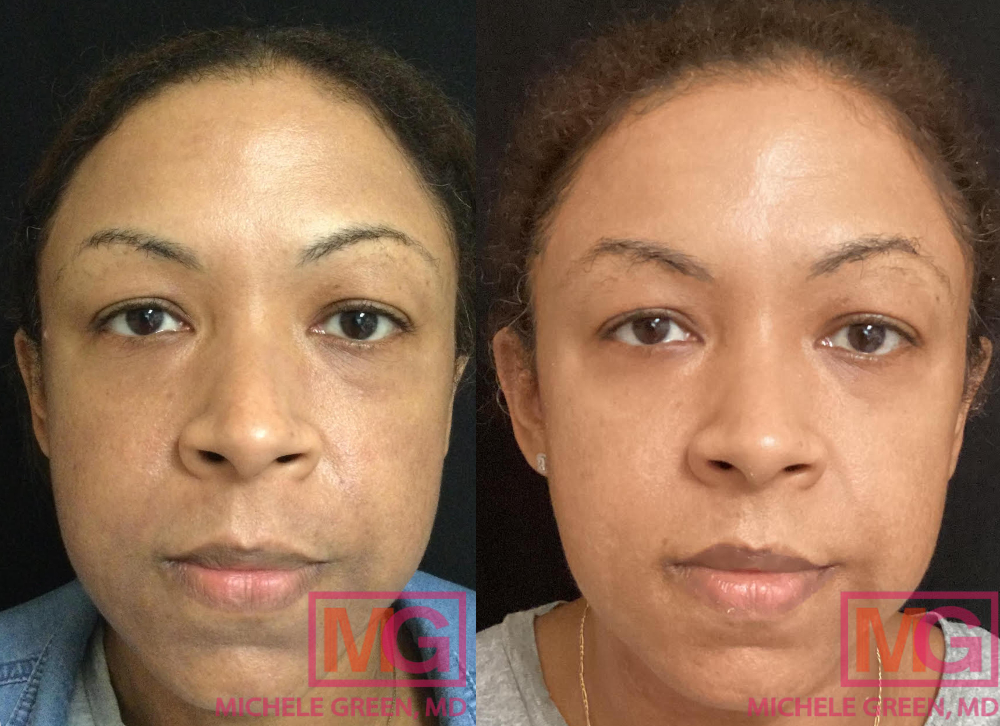
Cosmelan and Microneedling – before and after
Pseudofolliculitis
A common skin condition that Dr. Green treats in skin of color is razor bumps or pseudofolliculitis barbae. Pseudofolliculitis is a common condition in which shaving causes inflammation and bumps to develop on the skin. This medical condition is more common in men than women and commonly occurs on the face or neck. Clinically, one sees groups of red or dark bumps around each hair follicle, with characteristic inflammation. Treatment may consist of changing shaving habits, topical antibiotics, and in more bothersome cases, laser hair removal. Pseudofolliculitis also commonly occurs in patients who tweeze or pluck coarse hairs. Since the hairs tend to be more curved, the hair gets retracted below the skin surface and pierces the follicular wall from the inside. The result can lead to these painful bumps, which can scar, cause dark spots, and even keloids. Prompt medical attention by an experienced dermatologist, like Dr. Green, is essential to prevent these unwanted side effects and treat the underlying cause of this skin condition.
Tattoo removal for dark skin
Dr. Green is an expert at tattoo removal for various skin tones, including those with African American skin. For tattoo removals on darker skin, she uses the Alex TriVantage laser, which can remove tattoos after several sessions. The number of sessions depends on both the patient’s skin type and the various colors in the tattoo itself. A consultation with Dr. Green is the first step in formulating a treatment plan for your tattoo removal.
Any procedure, including laser treatment, has potential risks of hypopigmentation or hypertrophic scarring in darker skin tones. Because there is more melanin in darker skin, there is an increased potential of having the laser emit too much energy. This is why the laser tattoo removal process is a gradual one and requires multiple sessions.
The good news is that laser tattoo removal is relatively pain-free. Dr. Green will prescribe a topical numbing cream that can be applied one hour before your tattoo removal appointment to minimize discomfort. The sensation of laser tattoo removal is often described as an elastic band snapping against the skin. It can take a series of laser treatments, spaced approximately ten weeks apart, to clear your unwanted tattoo. The deeper the colors, such as pink and green, the more difficult it can be to remove the tattoo.
Hair loss in African American patients
In addition to skincare, there are numerous hair conditions that dermatologists like Dr. Green specialize in treating. Hair loss or alopecia is an extremely common concern for many patients. For some individuals, hair loss may occur due to genetics or hormones. For others, there is an increased association of hair loss with autoimmune diseases such as Lupus and Hashimoto’s disease. Many women suffer gradual hair loss from the hormonal fluctuations that occur during menopause. Others suffer from traction alopecia from hairstyles such as braids that are too tight. Dr. Green is a specialist in hair loss and will do a comprehensive examination and testing to identify the cause of your hair loss. Once the cause is identified, a comprehensive hair loss protocol will be designed for you. One of the most popular treatments for hair loss, for both men and women, is PRP injections for hair loss. By using your own blood, Dr. Green can utilize your natural growth factors and encourage the re-growth of thinning hair.
Cosmetic Dermatology in African American skin
Dr. Green is an internationally renowned expert in minimally invasive cosmetic procedures. Some of the most popular cosmetic procedures in her office are Botox, dermal fillers, lip augmentation, Kybella, Thermage, Microneedling, and neck rejuvenation. The accessibility and short downtime of these minimally invasive cosmetic treatments make them a perfect lunchtime procedure for those with busy lives. The current trend in cosmetic dermatology is for a more natural-looking result and general skin rejuvenation. Dr. Green’s “less is more” philosophy extends to Botox, where she believes in using “Baby Botox” or “Botox sprinkles” so that patients don’t look completely “frozen.” Similarly, with cheek augmentation and lip enhancement, the goal is to look younger, remove fine and deeper lines, and look refreshed while maintaining a natural-looking complexion. Through a combination of treatments, such as laser treatments, HydraFacials, dermal fillers, and the right skin care, the goal is to both restore and maintain these rejuvenated results.
Which treatment is best for dark skin?
The “best” treatment for patients with dark skin depends on the specific skin concerns that are to be addressed. Patients with darker skin should be cautious of undergoing lasers and harsh chemical peels, as ethnic skin is more prone to hyperpigmentation or post-inflammatory hyperpigmentation (PIH) due to the naturally higher amount of melanin in the skin. Discussed below are some cosmetic treatments offered at Dr. Green’s private dermatology office in Upper East Side that are safe and effective for dark skin, depending on the skin concerns you are looking to improve.
Chemical peels: Chemical peels are versatile in treating various skin concerns, including hyperpigmentation, acne scars, and acne. There are various types of chemicals that Dr. Green utilizes based on skin type, skin tone, and the specific skincare concern. Cosmelan peel is a professional-grade mask that can treat hyperpigmentation like melasma, PIH, sun spots, and age spots. Some examples of chemicals used in peels include trichloroacetic acid (TCA), beta-hydroxy acids (BHA), and alpha-hydroxy acids (AHA). The chemical reaction with the skin causes the superficial layer of dead skin cells to break down, revealing the healthy skin underneath that is more even in skin texture and tone. Through chemical exfoliation, chemical peels can improve acne by decongesting clogged pores. It is very important that strong chemical peels are avoided on dark skin, as this can cause adverse reactions like post-inflammatory hyperpigmentation. Different parts of the body require treatment using different types of acids. For delicate areas like the underarms (axilla) and inner thighs, Mesopeel provides a gentle chemical peel for skin-lightening that is safe for these sensitive areas. Mesopeel Periocular is specifically catered to the delicate eye area to improve pigmentation around the eyes. Dermamelan Intimate is a type of chemical peel specifically designed for the sensitive vaginal area for safely lightening the skin.
Microneedling: Microneedling, also known as collagen induction therapy, is a minimally-invasive procedure that can treat a variety of skin concerns, including acne scars, fine lines, skin discoloration, skin texture, skin laxity, and elasticity. This procedure creates controlled micro-injuries to the epidermis, stimulating the natural wound healing processes and inducing new collagen synthesis. The benefit of microneedling is that it can be enhanced and customized to specific needs. Platelet-Rich Plasma (PRP) is a serum derived from a sample of your own blood that contains growth factors that promote collagen and elastin synthesis and facilitates healing. The micro-channels in the skin created during the microneedling procedure allows for serums like PRP and Mesoestetic’s Depigmenting Solution to penetrate deeper into the skin and deliver maximum benefits. Radiofrequency (RF) microneedling like Vivace adds the collagen-producing benefits of RF for skin tightening and anti-aging along with the perks of microneedling to achieve a more even skin texture.
Laser Treatments: Lasers should be carefully selected for dark skin, as not all laser devices are capable of safely treating melanin-rich skin types. Thermage FLX is a gold-standard skin-tightening laser that delivers radiofrequency (RF) deep into the skin to induce collagen production and provide a tightening and lifting effect. Thermage is a “colorblind” laser that is great for a “mini face lift” and can also be used on various areas of the body like buttocks, thighs, and arms to diminish the appearance of skin laxity and crepey skin. For acne scars, Dr. Green utilizes the eMatrix sublative laser, which uses radiofrequency (RF) technology safe for darker skin tones to heat the deeper layer of the skin to stimulate collagen synthesis. Clear+Brilliant is a gentle fractionated laser that is safe for dark skin to improve visible signs of aging, sun damage, and skin texture. For laser hair removal, Dr. Green utilizes Candela GentleYAG for skin of color, and for laser tattoo removal, Dr. Green utilizes the Alex TriVantage laser.
Dermal Fillers: Dermal fillers are popular cosmetic injectable treatments that replenish and restore volume and soften the appearance of deep wrinkles. Popular hyaluronic acid dermal fillers include Juvederm, Restylane, and Belotero. Both Juvederm and Restylane have several different types of fillers within their families that are each catered to a specific area of the face. For example, Juvederm Voluma and Restylane Contour are thicker in consistency, making them perfect for cheek augmentation and mid-face contour correction. Sculptra is another type of filler made of poly-L-lactic acid, which is an injectable collagen stimulant that gradually and naturally restores lost volume and improves skin laxity. Dr. Green often utilizes Sculptra to improve the appearance of acne scars in the cheeks and temples, as well as for Sculptra butt lifts and hip dips.
Are chemical peels good for African American skin?
Generally, yes, chemical peels are a good treatment option for ethnic skin and dark skin. The type and strength of the chemical used should be carefully selected to prevent unwanted side effects like post-inflammatory hyperpigmentation. Darker skin tones are typically more sensitive than lighter skin tones and prone to hyperpigmentation due to the naturally increased amount of melanin or pigment in the skin. Other areas of the body that are more sensitive, such as around the eyes, inner thighs, and underarms, should be treated with gentle chemical peels that are catered for delicate skin, such as Mesopeels. When performed by an experienced, board-certified dermatologist like Dr. Green, chemical peels can improve the appearance of fine lines and wrinkles, lighten pigmentation to produce a more even skin tone, and treat acne breakouts through chemical exfoliation.
Is microdermabrasion good for African American skin?
Microdermabrasion is a minimally-invasive cosmetic procedure that physically exfoliates the top layer of the skin to remove impurities and dead skin cells to reveal healthy, new skin underneath that is more even in skin tone and texture. Crystal microdermabrasion utilizes fine crystals that is gently sprayed on the skin to buff away the top layer of dead skin cells. Diamond microdermabrasion utilizes a diamond-tipped hand piece to gently buff away dead skin cells. HydraFacial is a medical-grade hydradermabrasion system that deeply cleanses, exfoliates, and hydrates the skin. Because these procedures are gentle and target only the superficial layer of the skin, it is safe for all skin types including ethnic skin and dark skin. It is important to note that dermabrasion, a more intense surgical procedure that “sand away” top layers of the skin, is not safe for black skin because it can result in scarring or discoloration.
Laser Hair Removal for dark skin
African American patients must carefully select the appropriate laser for their skin tone. Laser hair removal procedures are highly sensitive to all colors and melanin, which is critical in treating darker skin types. The laser is typically designed to target water, hemoglobin, or brown melanin. If the proper wavelength or depth of penetration is not correctly set for darker skin patients, the skin can be easily damaged.
Dr. Michele Green utilizes the Candela GentleYAG (ND:Yag laser) since this laser is equipped with long wavelengths and pulse width, which is most effective and safe for ethnic tones and all darker skin patients. The reason the GentleYAG works so well is that it penetrates deeper than traditional laser treatments, which means the pigment in the skin is not affected in the same way. The GentleYAG laser can bypass the melanin on the surface of the skin and targets the hair root, providing safe and effective results. One of the risks with laser hair removal is hyperpigmentation or hypopigmentation (white spots) from the laser treatment. The Candela Gentle Yag was designed specifically for patients with darker skin tones to avoid this unwanted side effect.
Does black skin need sunscreen?
Yes! Sunscreen is an essential component of everyone’s skincare routines, including those with darker skin. The harmful effects of the sun’s ultraviolet (UV) rays cause sun damage like fine lines, wrinkles, and discoloration, along with skin cancer. When the UV rays make contact with unprotected skin, it causes changes in DNA at a cellular level, permanently damaging the skin’s structure. There are different types of UV rays: UV-A and UV-B. UV-A rays cause damage at all levels, ranging from the epidermis to the dermis. UV-A damage collagen and elastin fibers in the dermis, which are responsible for providing youthfulness and elasticity to the skin. UV-B rays cause photoaging and actinic keratosis (precancerous cells) by damaging the DNA on the epidermis. Therefore, it is important to seek out “broad-spectrum” sunscreens with at least SPF 30 that protect against both UV-A and UV-B rays.
Signs of photoaging include wrinkles, decreased elasticity, and pigmentation changes such as age spots, sun spots, and freckles. UV rays also stimulate melanocytes, which are skin cells responsible for producing melanin or skin pigment. With frequent UV exposure over time, the melanin produced by melanocytes clumps together to produce sun spots. Furthermore, skin conditions like melasma can be triggered or exacerbated by UV exposure. Melasma occurs when melanocytes are overstimulated and produce too much melanin. As discussed, the sun’s UV rays stimulate these melanocytes to produce melanin, worsening the melasma present on the skin. Because UV rays penetrate deep into the skin, the signs of photoaging may not appear on the skin until years later. Therefore, daily sunscreen application and reapplication is an essential part of skincare to prevent early signs of aging, sun spots, and of course, skin cancer.
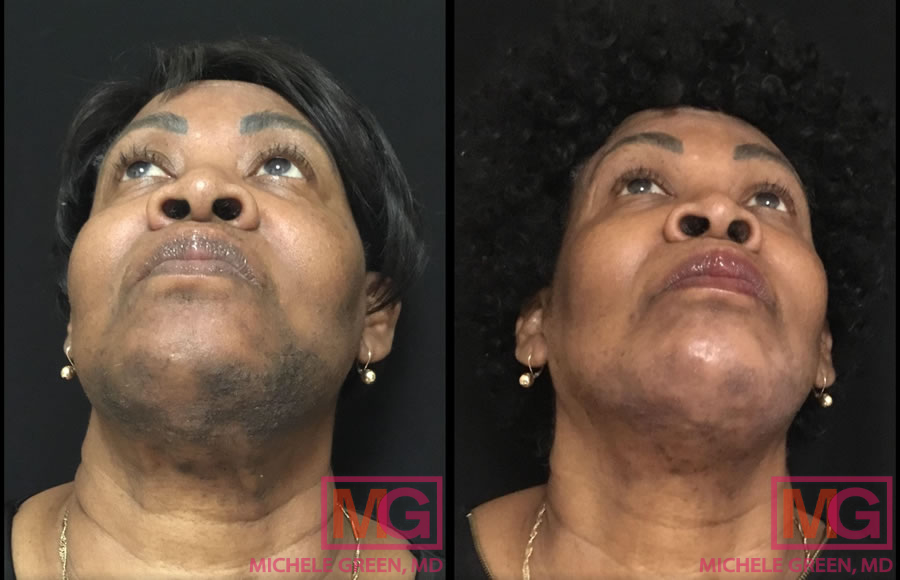
Female – Before and after Chemical Peel (2 treatments)
Should African American patients go to a dermatologist?
Yes! Since Black Americans make up about 13% of the population in the United States, and only about 3% of dermatologists identify as Black, many people may initially feel hesitant about going to the dermatologist. Even if you are treated by a provider who is not African American themselves, when you have an appointment with an experienced and knowledgeable board-certified dermatologist, like Dr. Green in New York City, you can guarantee that your skin concerns will be safely and effectively addressed. The skin is the largest organ of the body and requires regular maintenance and care to keep it functioning at its best. Dr. Green is well-versed in the diagnosis and treatment of skin conditions in patients of every skin tone, and can recommend the best in specially formulated skincare products and in-office treatments to keep you looking and feeling refreshed, radiant, and healthy.
Is African American skin dry or oily?
African American skin can be dry or oily, however, African American skin generally tends to be on the oilier side. This is due to the fact that there are typically larger and more numerous oil glands present in African American skin. Oily skin can be a benefit when it comes to preventing the development of signs of aging. Oil acts as a lubricant for the skin, keeping it moisturized and helping to combat the formation of fine lines, wrinkles, and skin laxity. If you’re unsure as to what skin type you have and are interested in learning more about the best practices for skincare, schedule a consultation with Dr. Green in NYC. Dr. Green is a board-certified dermatologist with over 25 years of experience treating men and women of every skin tone and skin type, and can help you personalize your skincare regimen so that it is perfectly tailored to the unique needs of your skin.
Can African Americans get skin cancer?
Yes, African Americans and patients with darker skin can get skin cancer. Skin cancer screenings are the most common exams performed in medical dermatology. Dermatologists, like Dr. Michele Green in NYC, diagnose and treat a myriad of skin conditions, including alopecia, melasma, dermatosis papulosa nigra (DPNs), and skin cancer. Skin cancer is an important consideration that is too often forgotten about or misdiagnosed in patients with skin of color.
Dr. Michele Green offers each new patient a complete skin cancer examination since all patients are susceptible to the serious effects of skin cancer. Although patients with darker skin tones are less likely to develop skin cancer than fair skinned patients, their survival rates are lower, too. This has to do with the fact that darker skinned patients are often diagnosed with skin cancer in its later stages. According to the Skin Cancer Foundation, the 5-year survival for African American patients in the United States is 65% compared with 91% in Caucasian patients. In general, skin cancer among black people in the U.S. accounts for 1-2 percent of all skin cancers, Hispanic patients 4-5 percent, and Asian patients 2-4 percent. Since it can be more difficult to diagnose skin cancer in darker skin patients, it is very important to consult an expert dermatologist with experience treating skin of color, since the delay in diagnosis can have such serious implications.
The most common area for patients with dark skin to develop skin cancer is on the bottom or plantar surface of the foot. Between 30 and 40 percent of all skin cancers in people of color occurs in the plantar area of the foot. The most common areas for skin cancer in African American patients are:
- Palms
- Plantar surface of feet
- Mucous membranes, such as the mouth
- Lower legs
- Nails
- Anogenital area
The ABCDE acronym is used by dermatologists to check for any signs of skin cancer within a skin lesion. The acronym stands for asymmetry, border, color, diameter, and evolving within a lesion. Board-certified dermatologists, such as Dr. Green, will examine your moles and growths for any asymmetry, irregular borders, uneven pigmentation, new growths, or lesions that have changed over time. It is extremely important to have a complete skin cancer exam, especially for African American patients, since early diagnosis leads to prompt treatment and improved patient outcomes.
How many Black Dermatologists are there?
The American Academy of Dermatology reports that approximately 3% of dermatologists in the United States are African American. With very few available spots, any medical student can attest to the high level of competition for dermatology residency. However, representation in healthcare is important and essential, including in the field of dermatology. To increase the number of African American dermatologists in the U.S. and improve diverse representation, The American Academy of Dermatology Mentorship Program works to pair underrepresented students in medical school with established dermatologists.
How to find a Dermatologist with expertise in treating African American skin
Whether you’re in need of a routine skin cancer exam, interested in cosmetic treatments like Botox or peels, or seeking guidance regarding your daily hair and skin care regimen, it is important to find a dermatologist that understands and appreciates the various needs of patients with different skin types and tones. Being seen by a provider that is experienced and knowledgeable regarding skincare for people of color helps guarantee the best outcomes for patients with darker skin and enhances the overall patient experience. Finding a dermatologist with experience treating African American skin concerns, whether they be medical skin conditions or cosmetic skin concerns, may feel challenging. Luckily, Dr. Michele Green in New York City is here to help. Dr. Green is an internationally renowned board-certified dermatologist with over 25 years of experience providing her patients from around the world with the best non-invasive treatment options available. For her dedication to her patients and expertise, Dr. Green is consistently voted as one of NYC’s best dermatologists by Castle Connolly, New York Magazine, The New York Times, and Super Doctors. When you consult with Dr. Green, you can feel confident that your dermatologist is dedicated to providing you with the treatment options best suited to your skin type that will help you look and feel your absolute best. To schedule a consultation with Dr. Green, call the NYC-based office at 212-535-3088 or contact us online today.
 212-535-3088
212-535-3088